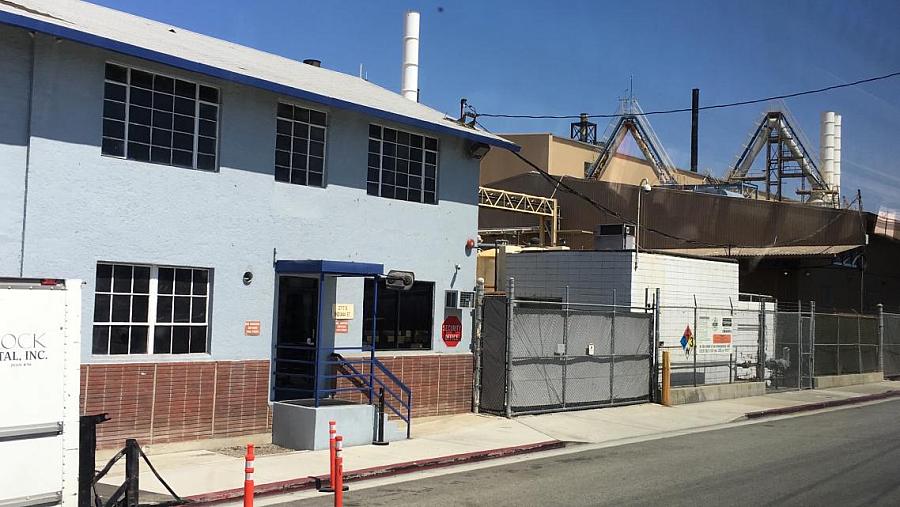Two environmental reporters share smart tips for covering the beat

The former Exide battery recycling plant in Vernon, California.
(Center for Health Journalism file photo)
Environmental reporter Tony Briscoe of the Los Angeles Times and independent investigative reporter Joe Rubin are veterans of the beat. Their deep dives into environmental pollution and regulatory failure have cast fresh light on some of the state’s most enduring calamities. They’ve both done extensive reporting, for instance, on the former Exide battery recycling plant in Los Angeles, which has poisoned workers and nearby residents for more than a half century, while a faltering cleanup stretches on.
The two reporters shared insights and takeaways with fellows at the 2023 California Health Equity Fellowship in Los Angeles this week, in a conversation moderated by the Center’s Jacqueline Stenson. From characterizing links between the environment and health to talking to industry representatives, Briscoe and Rubin offered a number of useful suggestions for reporters tilling similar ground.
Translating complex stories
Whether it’s a stew of brownfield contaminants in a proposed housing development or worrying levels of particulate matter in the air, it can be a challenge to render the complex science behind many environmental threats in a way that audiences can readily grasp.
“My first rule is always: You can’t talk to the reader like an expert,” Briscoe said. That might mean including an explainer on why higher humidity levels put added stress on the body during heat waves, for instance, or conveying the everyday impacts air pollution has on a family with an asthmatic child.
Likewise, Rubin emphasized the need to balance the story’s data and science with personal stories that bring the issue home for readers. “If you overwhelm people with statistics, it’s hard for them to absorb the story,” he said.
Linking the environment to health
Establishing that a specific toxin or source of pollution caused a particular health outcome is rarely possible. It poses some real challenges for journalists seeking to connect the dots without overstepping the science.
“Causation is the most difficult thing to prove,” Briscoe said. Sometimes, there will be clear evidence to point to — elevated blood levels, for instance, in exposed workers, as Rubin reported. But such inescapable links tend to be the exception on the environmental beat.
“Overwhelmingly, what you’ll want to do is be uncomfortable with uncertainty,” Briscoe said, adding that it pays to be very careful in the language used when linking environmental harms to health problems. For his story on the problem-plagued cleanup of homes in the shadow of the former Exide plant, Briscoe laid out a series of suggestive facts without asserting causation. He tells the story of an East Los Angeles family whose yard had lead levels seven times higher than the state standard. The family’s daughter has delayed speech; the grandmother who liked to garden died suddenly of cancer.
“Those facts individually are indisputable, but you don’t want to say that the arsenic from Exide caused that,” Briscoe said. “Readers can draw the lines and the conclusions for themselves.”
When it’s time to talk to industry
While it’s essential to reach out to companies and businesses connected to the environmental harm in question, getting them to talk on the record in a meaningful way is typically difficult.
While reporting his story on lead pollution from California gun ranges, Rubin discovered that one gun range owner had tasked about a dozen Boy Scouts with the task of retrieving spent ammunition from piles of sand laden with toxins. Rubin got the owner on the phone, for the first and last time.
In such instances, Rubin advised, “keep talking to them, record the conversation, because you’re never going to get them again. They’re going to lawyer up, and they’re going to figure it out.”
Briscoe added he often waits until his reporting is well along before reaching out to a company representative. “You definitely need to have all your facts ready because that could be the only chance you get to speak with them,” he said.
Listen to the community
Talk to the experts, follow the document trail, hear what industry has to say. But from start to finish, both reporters emphasized the importance of listening to the community.
When he arrived at the Los Angeles Times a year ago, the Exide story had already been extensively reported, and the cleanup had been underway for six years. His question was, “What’s new here?”
“Time and time again, after talking to residents, they’d say, ‘This cleanup is not being handled right.’” And they could tell him in great detail just how it was going wrong.
As Briscoe put it: “I think what any journalist will tell you is that no one knows the story better than the community.”

